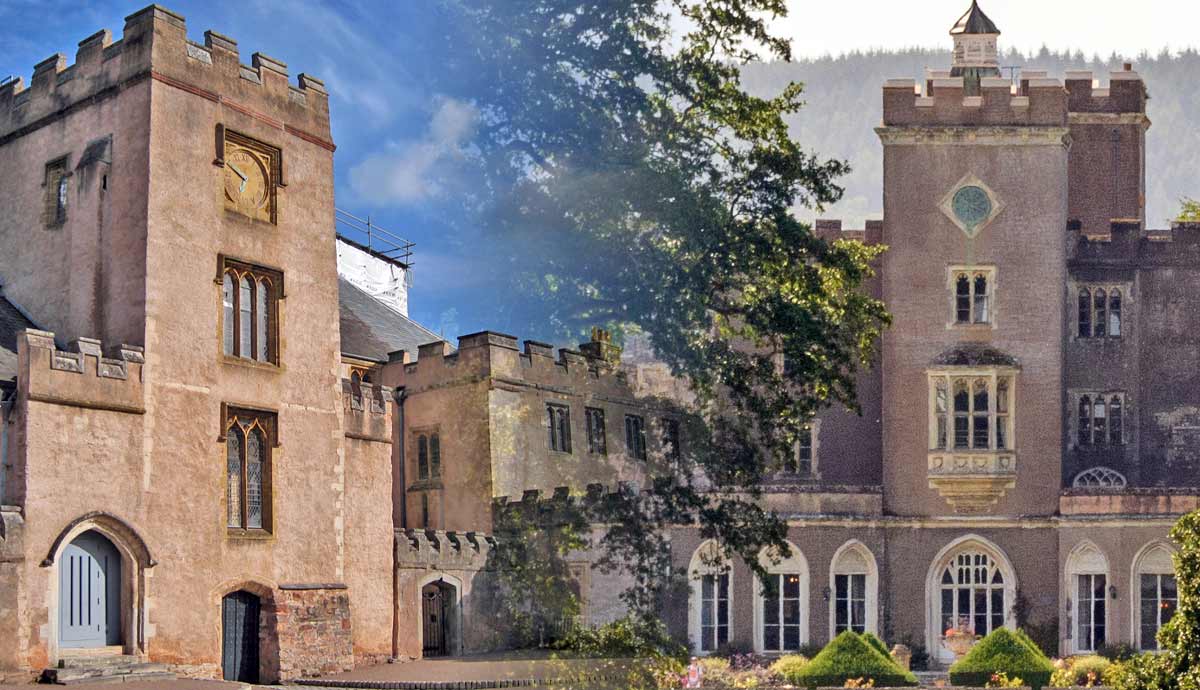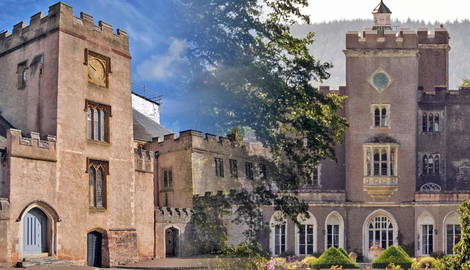
While many visit Devon’s southwest coastline to peruse quaint harbor towns on the English Riviera, hidden inland and along Devon’s coast are historical sites ripe for discovery. Devon was once covered in Bronze Age settlements. Its historical buildings transport visitors back in time to discover life in the Georgian, Tudor, and Victorian eras. Home to England’s largest commercial rabbit warren and a castle that developed a long-standing reputation for backward justice, here are eight historical sites you must visit in the beautiful English county of Devon.
1. Roam Around the Pillow Mounds Surrounding Ditsworthy Warren House

Ditsworthy Warren House can be found in an isolated location close to the southwestern Dartmoor county border. The Grade II-listed building is quite small and was built using granite rubble covered by an external render, a few patches of which have survived. About a square kilometer of the surrounding area once featured 53 “pillow mounds,” which were rectangular-shaped stone mounds covered with earth. These mounds had an average length of about 16 meters and a height of one meter and offered shelter to rabbits. Despite the widespread belief that rabbits belong in the British countryside, the species are not native to Britain. In fact, evidence suggests that they were introduced in Roman times and later died out (there is no Old English word yet discovered that means rabbit).
The furry mammals were later reintroduced by the Normans sometime in the 11th or 12th century. Rabbit meat was considered rare and expensive. It is thought that Ditsworth Warren House was the largest rabbit warren at one point; however, historical records are somewhat unclear. Ditsworth House was first mentioned in 1474, but records of rabbit keeping from that time cannot be confirmed. Various parts of the current Warren House were believed to be constructed in the 18th and 19th centuries or perhaps earlier in the 16th century. The house was abandoned in 1947, and although the area is private property, access is possible via bridleways that converge near the property.
2. Gaze Up at Dartmoor’s Famous Haytor Rocks

This obtuse lump of rock is recognized as a Site of Special Scientific Interest, and many view it as one of Dartmoor’s most famous landmarks. Its name, “Haytor,” is likely an adaptation of the name “Haytor Hundred,” which refers to a group of ancient administrative units that used to operate in the county. Along with other adaptations like “Hay Tor” and “Hey Tor” in recent times, in the past, it was called “Itterdown” (1789), “Idetor” (1737), and “Idetordoune” (1556), among other names.
The rock is a large granite “tor,” sometimes also referred to as a “castle koppie” or “kopje.” These free-standing rocks are often found jutting out of hill summits in a manner that contrasts with the smooth hill slopes below. At Haytor, the granite between the two main outcrops has suffered erosion, giving the rock formation a distinct shape visible from many locations across south Devon. Granite quarries and an iron mine can be found nearby, and when a variety of quartz was discovered in the latter, it was named “Haytorite” in honor of where it was found.
3. Walk Among the Ancient Hut Circles at Grimspound

Grimspound is a very interesting historical location, not least because past and present experts have dated the site from between the Bronze Age (2500-600 BCE) through to the Early Iron Age (600-400 BCE). Disagreement over the use of the site is also widespread, with suggestions varying from an Iron Age fort to a permanent Phoenician settlement and even an encampment for tin miners. The area is home to a low stone wall encompassing a set of 24 hut circles. The entrance to the area is the most prominent, with a 5.5-meter-long corridor lined with megaliths and other large stones.
The name “Grimspound” likely stems from the name of the Anglo-Saxon god of war, “Grim,” and was granted to the site in 1947 by a Cornish Reverend. An archaeological dig commenced in 1893 and concluded in 1894 with a reconstruction of the site. Although the excavation was quite progressive at the time–the archaeologists used sieves to recover charcoal and seeds, among other items–it is also viewed as quite controversial. Evidence of bias and methodological errors have led experts to question its findings that the site was a Neolithic cattle enclosure. Today, it’s possible to walk about the area, view the hut circle outlines, and ponder the different reasons for the layout of the stones.
4. Visit Lydford Castle, Home to the Infamous Term “Lydford Law”

Lydford Castle was the first castle to be built in Lydford and was originally called the “Norman fort,” as it was built after the Norman conquest of 1066. Following the Norman invasion, the English pushed back against Norman rule, and the Normans worked hard to keep order and control. The fort was used by the Normans when a revolt took place in 1068; however, by the 12th century, it had largely been abandoned. The castle that stands today was constructed in 1195 and operated as a prison and court, helping implement law and order in the Devon “stannaries,” areas of administration in Devon, and the Dartmoor Forest. It has been described by historian Andrew Saunders as “the earliest example of a purpose-built gaol” in England.
Apart from a few periods, the castle continued to perform administrative duties through the early 19th century, gaining a bad reputation for a very backward approach to justice. Consequently, the term “Lydford Law” became a term that was synonymous with judicial cruelty. William Browne’s 1644 poem illuminated the court’s guilty-until-proven-innocent approach, and Lydford’s reputation was not quickly forgotten in the centuries thereafter. Lydford Castle was built to resemble a motte and bailey castle, with the stone castle situated on a raised mound (the “motte”) and surrounded by a walled courtyard (the “bailey”). Since 1342, the castle has belonged to the Duchy of Cornwall, a title currently held by Prince William, Duke of Cornwall. He is also the son of Charles III, who has been the King of the United Kingdom since 2022. Today, English Heritage manages tours at Lydford Castle, while the National Trust owns the earthworks of the Norman fort.
5. Stand in the Footsteps of Neolithic Settlers at the Prehistoric Settlement of Merrivale

Situated in western Dartmoor, the hamlet of Merrivale had a thriving quarrying community in recent centuries. Following the closure of the quarry in 1997, many people continue to visit the area as remains of Bronze Age (2300–800 BCE) megalithic monuments can be found alongside a Neolithic (3000–2300 BCE) ritual site. Visitors can discover a set of Neolithic stones, including a standing stone with a height of 3.8 meters, a stone circle, and a stone row. Most notable is a series of Neolithic “cairns,” which are earth mounds that people used for burial purposes. Traces of a cluster of roundhouses suggest that Bronze Age settlers also made Merrivale their home.
The area is also of geological importance, as the hamlet is partially situated on a granite outcrop. To the west of Merrivale is a metamorphic aureole caused by contact metamorphism, whereby magma rises up to meet cooler country rock. Merrivale Granite is distinguished by its crystals, which are a mixture of orange, white, cream, and dark gray. The local area welcomes visitors, and historical enthusiasts can explore the stone features of Merrivale’s prehistoric settlement up close.
6. Explore 900 Years of History at Torre Abbey

This medieval monastery was founded in 1196 for Premonstratensian canons of the Catholic Church. It is one of the best-preserved buildings of its kind and today is home to the third-largest art collection in the county. Perhaps the peak of Torre Abbey’s history can be marked by the period when it was the wealthiest Premonstratensian house in England. However, in 1539, the abbey was surrendered to King Henry VIII and largely demolished. The east range and the church were stripped of all valuable items, right down to lead in the roofs. The west and south ranges were converted into a home, and perhaps for this reason, the cloisters in both ranges are some of the few original features that have survived.
In 1662, the converted house became home to the Cary family, who would live there for close to 300 years. There is a selection of buildings in the complex, with a gatehouse dating back to 1380 and a tithe barn dating back to the 13th century. The barn was named “The Spanish Barn” after it held 397 Spanish Armada prisoners for two weeks in 1588. The abbey has a distinctly Georgian style owing to renovations that took place in 1740. Today, it’s possible to visit the abbey, learn more about its history, and explore the grounds and expansive gardens.
7. Meet an Old Navigational Aid Still in Operation at Teignmouth

In the 1800s, clay exportation from Devon to the English Midlands was a booming business, with much of the transportation taking place via the seas. In 1843, the construction of a canal linking called the “Hackney Cut” came to completion. This allowed vessels to get closer to Kingsteignton and the surrounding areas, locations where much of the clay was coming from. Up to 16 clay storage cellars were built, which held the clay before it was moved to Teignmouth for its onward journey. Consequently, the little Port of Teignmouth became a hub of activity with large, heavily laden vessels transporting clay, granite, culm, timber, and coal to and from the area.
The constant activity churned up the sea bed, which, combined with strong currents, shifting sands, and the presence of low-lying vessels, made the mouth of the river Teign a hazardous area of water. To assist the cargo ships, a lighthouse was erected on the Teignmouth side of the harbor entrance. By lining up with a fixed red light viewable from up to seven nautical miles from the lighthouse, large incoming vessels would know when to safely turn into the mouth of the river Teign. Construction was completed in 1845, costing £196 and seven shillings (equivalent to around £11,800 or $15,000 today). The lighthouse was met with some criticism from the locals; however, this historical navigational aid still operates to this day.
8. Discover Six Centuries of English History at Powderham Castle

In 1391, Sir Philip Courtenay built a medieval great hall and named it Powderham. The name comes from an ancient Dutch word, “polder,” which means “the hamlet of the reclaimed marshland.” The property was intended to serve as a home, both for the Courtenay family and for the wider community. Over the centuries, renovations to the building have left it with a beautiful mix of Tudor (1485-1603), Georgian (1714-1837) and Victorian (1837-1901) features. As well as architectural history, Powderham boasts a rich history of local and national politics, telling stories of the Battle of Agincourt (1415), the War of the Roses (1455-1487), the English Civil Wars (1639-1652), and even World War II (1939-1945).

Sir Philip Courtenay came from a family of French knights, and upon establishing the manor house in Powderham, the family began to collect and display an array of valuables, showcasing everything from items of local craftsmanship to works of esteemed artists. Today, it’s possible to discover all kinds of wonderful historical items, both on display and behind secret doors that lead to sneaking passageways that cut through the medieval walls. Although not technically a medieval castle, the name “Powderham Castle” came about sometime in the 17th century and has stuck ever since. Castle-like features were added later in the 19th century. Today, it is possible to explore the many rooms and grounds to discover over six centuries of political, military, and cultural history.










